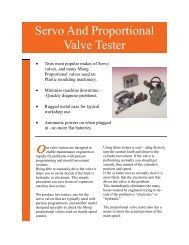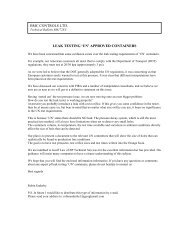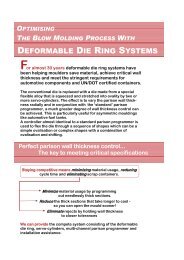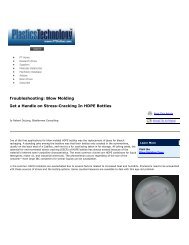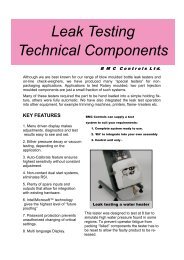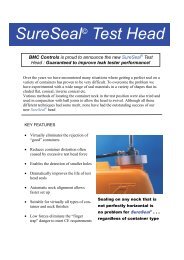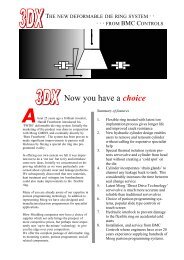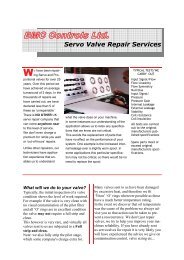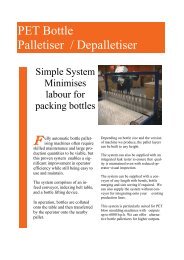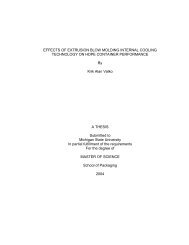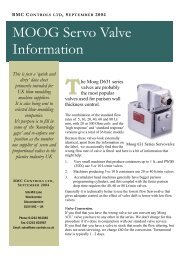internal cooling for the blow molding industry - Blow Moulding Controls
internal cooling for the blow molding industry - Blow Moulding Controls
internal cooling for the blow molding industry - Blow Moulding Controls
Create successful ePaper yourself
Turn your PDF publications into a flip-book with our unique Google optimized e-Paper software.
The illustration {A} below shows a stagnant air <strong>blow</strong> process, <strong>the</strong> conventional <strong>blow</strong> process, in which <strong>the</strong> <strong>blow</strong> pin fills <strong>the</strong> pre<strong>for</strong>m<br />
with compressed air and keeps a maximum pressure inside <strong>the</strong> product in a mold cavity until <strong>the</strong> mold cools <strong>the</strong> product to <strong>the</strong> desired<br />
temperature. The compressed air is vented be<strong>for</strong>e <strong>the</strong> mold is opened to allow <strong>for</strong> <strong>the</strong> product to be transferred to <strong>the</strong> trimming station.<br />
Illustration {B} shows compressed air exchange. The <strong>blow</strong> pin design in this example is not ideal and <strong>the</strong> air is only guided to <strong>the</strong> lower<br />
part of <strong>the</strong> container. The example illustrated in {C} shows a high back pressure inside <strong>the</strong> container and <strong>the</strong> air can not reach to <strong>the</strong><br />
bottom of <strong>the</strong> product.<br />
The example in illustration {D} shows a good <strong>blow</strong> pin design and a good air distribution. The air in this case is guided to <strong>the</strong> critical<br />
areas of <strong>the</strong> container. The back pressure is high enough to keep contact between <strong>the</strong> product and <strong>the</strong> surface of <strong>the</strong> cavity and it is low<br />
enough to allow turbulent air flow.<br />
The air exchange is started after <strong>the</strong> initial <strong>blow</strong> of <strong>the</strong> pre<strong>for</strong>m with stagnant air. The initial <strong>blow</strong> time is set to be just long enough to<br />
stretch <strong>the</strong> pre<strong>for</strong>m to <strong>the</strong> shape of <strong>the</strong> cavity and vent all <strong>the</strong> ambient air between <strong>the</strong> product and <strong>the</strong> mold cavity. The product is finally<br />
vented be<strong>for</strong>e <strong>the</strong> mold is opened.<br />
The illustration to <strong>the</strong> left below shows <strong>the</strong> initial <strong>blow</strong> process. Both valves {B} and {C} are opened and <strong>the</strong> valves {A} and {D} are<br />
closed. Compressed air {P} is flowing to <strong>the</strong> <strong>blow</strong> pins through <strong>the</strong> machine’s manifold {M} and <strong>the</strong> air distributor {L}. A simple <strong>blow</strong><br />
pin in a coaxial configuration is illustrated in a large size showing <strong>the</strong> air flowing in both channels to <strong>the</strong> product. The pressure indicated<br />
on <strong>the</strong> gauge {G} shows <strong>the</strong> maximum air pressure available <strong>for</strong> <strong>the</strong> process. The pre<strong>for</strong>m is stretched to <strong>the</strong> shape of <strong>the</strong> cavity and <strong>the</strong><br />
ambient air between <strong>the</strong> pre<strong>for</strong>m and <strong>the</strong> cavity is completely vented out.<br />
The illustration to <strong>the</strong> left below shows <strong>the</strong> valves {B} and {D} are opened while {A} and {C} are closed. The air now flows to <strong>the</strong> outer<br />
channel of <strong>the</strong> <strong>blow</strong> pin through <strong>the</strong> distributor {L}, washes <strong>the</strong> bottle removing heat from <strong>the</strong> inner surfaces and flows back through <strong>the</strong><br />
inner channel of <strong>the</strong> <strong>blow</strong> pin through <strong>the</strong> machines manifold {M} to <strong>the</strong> throttle valve {E} and <strong>the</strong>n finally vented out. The gauge shows<br />
Page 7 of 14<br />
1 (877) 91-FASTI




